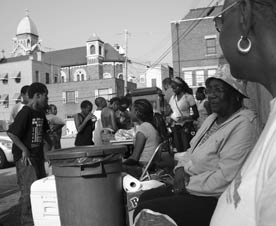In addition to strong relations with residents and law enforcement, partners are assigned “Safe Places” where they act as community liaisons. Safe Places are community resource centers geared toward the development of youth through recreation, education, and mentorship. Safe Places include schools, teen centers, the YMCA, YWCA and the City Park, Recreation and Forestry Department. Safe & Sound supplies $1.3 million to 30 Safe Places in Milwaukee’s high-crime neighborhoods. Partners must establish ongoing relationships with Safe Places to ensure positive working relationships between the Safe Place, Safe & Sound, law enforcement, and the broader community.
Every Wednesday evening, I work with a Safe Place called the Running Rebels Center in its youth music program. Running Rebels is a unique learning experience, housing a recording studio and a copy center in addition to community-center staples like pool tables and computers. Through the music program, youths 15 to 18 teach their younger peers how to write and record songs and use studio equipment.The older kids who complete the program are allowed to record songs, design their own flyers and CD artwork, and duplicate and print the product for distribution in the community.
After three and a half months on the job, I’ve realized two things. The first is that the word “community” is a verb, not a noun. Community is only a reality when there are those willing to give of their time to bring people together. The second thing I’ve learned is that service is not always a mutually agreeable action. Community organizers get called all kinds of names (often good, sometimes bad); they are cheered on from passing cars and told to keep up the great work. There are some residents who see cooperation of any kind with the police as taboo, while many residents welcome the opportunity to have their concerns heard by law enforcement.
It is only over time that the good deeds of those in service can be judged accurately by the public. Residents may never completely agree on the effectiveness of any community-service initiative or organization. It is a delicate balance of maintaining daily one-on-one contact with residents, canvassing neighborhoods, and cooperating with other community and local government organizations that allows Community Partners to have a personal impact on the lives of the citizens they serve.
Ultimately, all people — black, Latino, Asian, and white, poor and affluent alike — want the same for their families and their communities. Inner-city residents, however, often feel abandoned by a system that only seems to pay attention when a shocking incident like the Charles White killing occurs — an event that put Milwaukee in the national headlines in a way it hasn’t been since they pulled the skeletons out of Jeffrey Dahmer’s freezer.
Building trust between these citizens and those appointed to represent them is where a Community Partner can be most effective. In doing so, we often act as a conduit between alienated residents and their larger community. Many residents are reluctant to call upon officials they feel have ignored their pleas in the past, so they just stop calling. Community Partners have been answering their calls for nearly 10 years, no bat signal necessary.





Comments